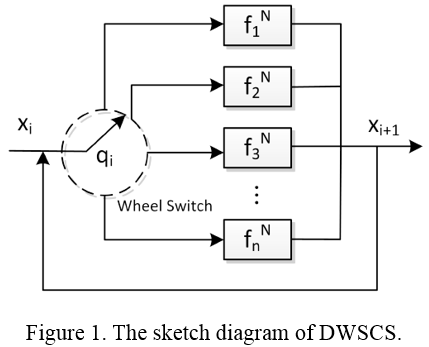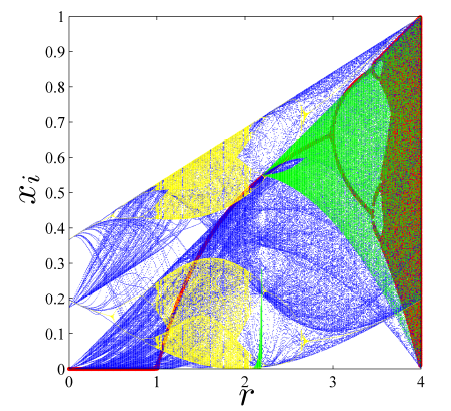Discrete Wheel-Switching Chaotic System
Introduction
This paper introduces a discrete wheel-switching chaotic system (DWSCS). Changing the controlling sequence of the wheel switch allows DWSCS to generate a large number of new chaotic sequences from a set of existing chaotic maps (seed maps). Simulations and analysis demonstrate the DWSCS’s characteristics and chaotic behaviors. An FPGA design of DWSCS shows its effectiveness in hardware implementation. We also investigate a direct application of a DWSCS as a pseudorandom number generator (PRNG). Our simulation results show that it passes NIST SP 800-22 test suite and has many desired features of a PRNG.
Discrete wheel-switching chaotic system
The new Discrete Wheel-Switching Chaotic System (DWSCS) consists of a controllable wheel switch and a set of normalized seed chaotic maps. Figure 1 illustrates the DWSCS’s sketch diagram. In particular, DWSCS utilizes the wheel switch to select one of the normalized chaotic maps in each iteration. The DWSCS’s output sequence is iteratively defined by Equation (4), where xi is the i-th input of DWSCS W, and 1≤ i ≤m, m is the length of the output chaotic sequence; 𝑞𝑖 is the i-th element in the controlling sequence Q with 𝑞𝑖 ∈{1,…,𝑛} and Huazhongyun10 denotes the i-th normalized seed chaotic function.
 |
Bifurcation diagram
In order to compare the bifurcation diagram of a DWSCS with a long Q, we put the bifurcation diagrams of chaotic seed maps together in Figure 2. It is obvious that the resulting DWSCS with a long Q has a much wider dynamic range than the superposition of all three chaotic seed maps. This simply means that a DWSCS is effective to introduce additional dynamic behaviors.
 |
| Figure 2. The superposed bifurcation diagrams (Red: Logistic map; Greeen: Tent map; Yellow: Gauss map; Blue: DWSCS with Q set to a length of 2187). |